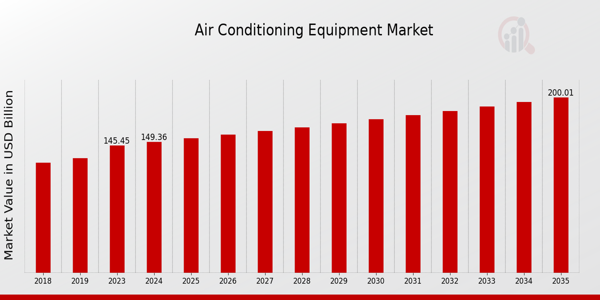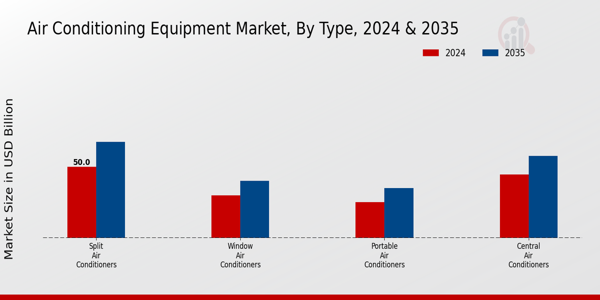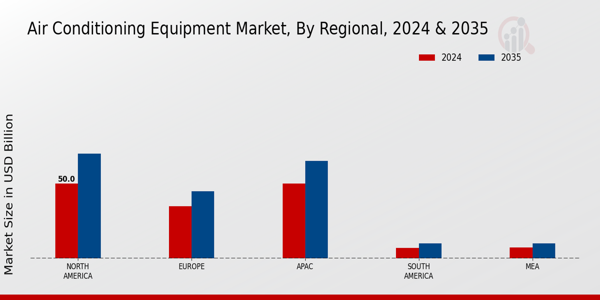Air Conditioning Equipment Market Overview
As per MRFR analysis, the Air Conditioning Equipment Market Size was estimated at 145.45 (USD Billion) in 2023.The Air Conditioning Equipment Market Industry is expected to grow from 149.36(USD Billion) in 2024 to 200.0 (USD Billion) by 2035. The Air Conditioning Equipment Market CAGR (growth rate) is expected to be around 2.69% during the forecast period (2025 - 2035).
Key Air Conditioning Equipment Market Trends Highlighted
The Global Air Conditioning Equipment Market is primarily driven by increasing global temperatures and the growing need for climate control in residential and commercial spaces. As urbanization continues to rise, more people are relocating to cities, leading to higher demand for efficient cooling systems. Additionally, advancements in technology, such as smart thermostats and energy-efficient designs, are pushing consumers towards modern air conditioning solutions. Concerns about indoor air quality and the need for effective ventilation systems also contribute to market growth.
There are significant opportunities to be explored in the market, particularly in developing regions where rising disposable incomes are leading to increased homeownership and commercial projects.Manufacturers that focus on sustainable practices, such as producing eco-friendly refrigerants, can capitalize on the growing trend of environmental consciousness among consumers. Additionally, innovations in IoT integration for smart homes are paving the way for advanced air conditioning systems that enhance user convenience and energy management. In recent times, the market has seen a shift towards more energy-efficient equipment driven by both regulatory mandates and consumer preference for greener solutions
. The adoption of variable refrigerant flow (VRF) systems is gaining traction as they offer flexibility and lower energy consumption.Moreover, replacing aging infrastructure in older buildings with modern systems is becoming a popular trend as stakeholders seek to improve efficiency and reduce operational costs. Companies are also focusing on after-sales services and warranties to enhance customer satisfaction and loyalty. As economies evolve and climate conditions change, the market will likely continue to adapt and innovate, making it a dynamic field for growth and development.

Source: Primary Research, Secondary Research, MRFR Database and Analyst Review
Air Conditioning Equipment Market Drivers
Increasing Urbanization and Population Growth
The rapid pace of urbanization across the globe is a significant driver for the Global Air Conditioning Equipment Market Industry. As more people migrate to urban areas seeking better employment and educational opportunities, the demand for residential and commercial spaces is escalating. Urban settings typically experience higher temperatures due to the urban heat island effect, creating an increased need for effective cooling solutions. Consequently, this drives the demand for air conditioning equipment, helping to ensure comfort in living and working environments.Moreover, as the population continues to grow, especially in developing nations, there is an expanding requirement for air conditioning in homes, offices, retail spaces and other public facilities. This trend of urban development not only drives the demand for new air conditioning units but also boosts the replacement market as older units are upgraded to more energy-efficient models. The synergy of increasing infrastructure development, urban living, and economic growth in major cities further propels the Global Air Conditioning Equipment Market Industry, thereby setting a robust foundation for sustained market growth in the coming years.
Technological Advancements in Energy Efficiency
Innovations in technology have significantly influenced the Global Air Conditioning Equipment Market Industry, particularly in energy efficiency. With rising energy costs and increased awareness of environmental concerns, consumers and businesses are increasingly opting for energy-efficient air conditioning units. Manufacturers are investing in research and development to enhance the efficiency of air conditioning systems, leading to the introduction of advanced technologies such as inverter compressors, smart thermostats and eco-friendly refrigerants.
Climate Change and Rising Temperatures
The impact of climate change is another crucial driver for the Global Air Conditioning Equipment Market Industry. With rising global temperatures and unpredictable weather patterns, there is an increased demand for cooling solutions to combat extreme heat. Regions that traditionally experienced mild climates are now witnessing spikes in temperatures, leading to a higher reliance on air conditioning systems for both residential and commercial applications.This climatic shift enhances the market need for robust air conditioning equipment that can efficiently manage heat, thus driving manufacturers to innovate and diversify their product lines. Consequently, as awareness grows about the importance of maintaining indoor comfort amid changing environments, the air conditioning market continues to flourish, supported by a collective focus on sustainability and heightened consumer expectations.
Air Conditioning Equipment Market Segment Insights:
Air Conditioning Equipment Market Type Insights
The Global Air Conditioning Equipment Market revenue showcases a significant segmentation by type, comprising Split Air Conditioners, Window Air Conditioners, Portable Air Conditioners, and Central Air Conditioners, each contributing uniquely to the overall landscape of the market. In 2024, the valuation for Split Air Conditioners stands at 50.0 USD Billion, positioning it as a dominant force within the market. This segment's popularity stems from its energy efficiency and effectiveness in cooling larger spaces, making it a preferred choice for both residential and commercial applications.Following closely, Window Air Conditioners are valued at 30.0 USD Billion in 2024. They are particularly favored in smaller living spaces due to their compact design and affordability, attracting a diverse consumer base.
Portable Air Conditioners also hold a valued position at 25.0 USD Billion, offering convenience as they can be easily moved from one room to another, appealing to consumers looking for flexible cooling solutions without extensive installation processes. Central Air Conditioners, valued at 44.36 USD Billion in 2024, are significant for their ability to provide consistent cooling throughout larger buildings, enhancing comfort in both residential and commercial settings.The Global Air Conditioning Equipment Market segmentation reflects a well-rounded distribution of preferences among various consumer needs and contexts, where the choices vary significantly based on factors such as space, energy requirements, and installation feasibility.
As the market evolves, factors such as technological advancements and a growing emphasis on energy efficiency are expected to spur growth across these segments. Each type plays a critical role in responding to the rising temperatures globally and consumers’ shifting preferences towards sustainable air conditioning solutions.The demand dynamics and market statistics are pushing manufacturers to innovate, ensuring that the offerings remain competitive and appealing in the face of growing environmental concerns and energy efficiency desires among consumers. With these elements in place, the Global Air Conditioning Equipment Market data illustrates a landscape ripe for development as new trends emerge and consumer lifestyles transform.

Source: Primary Research, Secondary Research, MRFR Database and Analyst Review
Air Conditioning Equipment Market Application Insights
The Global Air Conditioning Equipment Market revenue is expected to reach This market is segmented into various applications, namely Residential, Commercial, and Industrial, each contributing significantly to overall market dynamics. The Residential segment plays a critical role in driving demand as consumers increasingly prioritize comfort and energy efficiency in their homes. The Commercial segment generates substantial revenue as businesses seek reliable systems for optimal work environments, especially in sectors such as retail and hospitality.Meanwhile, the Industrial segment presents opportunities due to rising manufacturing and processing activities that require effective climate control solutions. As noted in Global Air Conditioning Equipment Market statistics, trends such as urbanization, rising disposable incomes, and the growing need for energy-efficient systems are fueling market growth. However, challenges like environmental regulations and the high cost of advanced technologies may impact the market's trajectory. Overall, the Global Air Conditioning Equipment Market segmentation reflects a robust framework that addresses diverse user needs across all segments.
Air Conditioning Equipment Market Cooling Type Insights
The Global Air Conditioning Equipment Market is experiencing steady growth, This growth is largely attributed to the increasing demand for efficient cooling solutions, especially in regions with extreme climates. Within the Cooling Type segment, differentiation can be observed among various cooling methodologies that cater to specific needs and environmental conditions. Air-Cooled systems are popular due to their ease of installation and lower maintenance costs, making them widely adopted in residential settings.Water-Cooled systems, on the other hand, are preferred in larger commercial applications, providing higher efficiency and performance. Meanwhile, Evaporative Cooling is gaining traction as it offers an eco-friendly alternative with lower energy consumption, especially in arid regions. This diversification in cooling technologies illustrates the dynamic nature of the market, responding to both consumer preferences and environmental considerations. As the industry adapts to new trends and technological advancements, the Global Air Conditioning Equipment Market statistics reflect a robust and evolving landscape, aiming to meet the growing demand for sustainable and effective cooling solutions.
Air Conditioning Equipment Market End Use Insights
The Global Air Conditioning Equipment Market has shown significant growth across various end-use categoriesWithin this market, the household segment holds a substantial share, driven by rising consumer disposable income and the increasing popularity of smart home systems. Additionally, offices are seeing an expanding demand for energy-efficient cooling solutions as businesses strive to enhance employee comfort and productivity. The retail sector also plays a vital role, with climate control systems being essential for maintaining product quality and enhancing customer experience.Each of these categories contributes to the overall market dynamics, reflecting trends toward sustainability and technological advancements. Factors such as urbanization and temperature fluctuations are primary drivers behind the strong demand for air conditioning across these end-use applications, further solidifying their importance in the Global Air Conditioning Equipment Market evolution. The market data indicates an upward trajectory, as challenges like rising energy costs present opportunities for innovation and development of more efficient systems.As the Global Air Conditioning Equipment Market continues to expand, stakeholders should closely monitor these segments for strategic planning and investment.
Air Conditioning Equipment Market Regional Insights
The Global Air Conditioning Equipment Market is projected to reach a significant value, showcasing the importance of various regional markets. In 2024, North America holds the largest share with a valuation of 50.0 USD Billion, driven by high demand for energy-efficient cooling solutions primarily in residential and commercial sectors. Europe follows closely, valued at 35.0 USD Billion, reflecting a strong emphasis on environmental regulations and sustainable technologies. APAC is equally vital, matching Europe at 50.0 USD Billion, primarily due to rapid urbanization and rising temperatures, which propel the demand for air conditioning systems.South America, while valued at 7.0 USD Billion in 2024, presents substantial growth opportunities as economies develop and consumers prioritize comfort. The Middle East and Africa (MEA) segment, with a valuation of 7.36 USD Billion, also exhibits potential due to extreme heat conditions driving air conditioning needs. Overall, the regional dynamics showcase robust market growth driven by technological advancements, increasing disposable incomes, and the quest for efficient cooling solutions, with varying dominance across regions reflecting their specific market conditions and consumer behaviors.

Source: Primary Research, Secondary Research, MRFR Database and Analyst Review
Air Conditioning Equipment Market Key Players and Competitive Insights:
The Global Air Conditioning Equipment Market is characterized by a dynamic landscape where innovation, energy efficiency and sustainability are driving competitive strategies. The competition among key players is intensifying as companies leverage advanced technologies to enhance their product offerings while addressing growing environmental concerns and regulatory requirements. Major manufacturers strive to capture market share by focusing on improvements in energy efficiency, smart technology integration and user-centric features. With rising global temperatures, urbanization, and an increasing demand for air conditioning solutions, companies are investing in research and development to stay ahead of market trends and consumer preferences, leading to a highly competitive environment.Mitsubishi Electric has established a strong presence in the Global Air Conditioning Equipment Market, recognized for its commitment to innovation and quality.
The company is renowned for its advanced HVAC systems that incorporate cutting-edge technology aimed at maximizing energy efficiency and minimizing environmental impact. Mitsubishi Electric's strengths include a robust product portfolio that caters to both residential and commercial segments, with particular emphasis on inverter technology and variable refrigerant flow systems. The brand's dedication to research and development allows it to continuously enhance efficiency ratings and provide environmentally friendly solutions, positioning Mitsubishi Electric as a leader in sustainable air conditioning solutions. Additionally, its global reach ensures access to a diverse clientele, further solidifying its competitive edge in the marketplace.LG Electronics has emerged as a formidable player in the Global Air Conditioning Equipment Market, distinguished by its emphasis on innovation and smart technologies.
The company has built a reputation for designing energy-efficient products that integrate seamlessly with modern smart home systems. By leveraging its expertise in electronics, LG Electronics has developed advanced air conditioning units featuring intelligent climate control, which automatically adjusts settings for optimal comfort while reducing energy consumption. The extensive range of products offered by LG includes both residential and commercial solutions, enabling it to cater to a variety of customer needs. Furthermore, LG's proactive approach to meeting environmental regulations and consumer preferences positions it favorably in the market, reflecting its commitment to sustainability and technological advancement. This focus not only enhances LG Electronics' competitive strengths but also contributes to its enduring appeal in the air conditioning sector.
Key Companies in the Air Conditioning Equipment Market Include:
- Mitsubishi Electric
- LG Electronics
- Trane Technologies
- Whirlpool Corporation
- Samsung Electronics
- Panasonic
- Fujitsu General
- Carrier Global
- Johnson Controls
- Sharp Corporation
- Daikin Industries
- Midea Group
- Gree Electric Appliances
- Hitachi
- Voltas Limited
Air Conditioning Equipment Market Industry Developments
In recent developments within the Global Air Conditioning Equipment Market, several key players have been active in enhancing their product offerings and expanding their market reach. Mitsubishi Electric, for instance, has introduced advanced environmentally friendly systems aimed at increasing energy efficiency. LG Electronics continues to innovate with its AI-powered air conditioning units, which have gained significant consumer interest. Trane Technologies and Carrier Global are focusing on sustainable solutions, reflecting a market shift towards greener technologies. The recent merger between Whirlpool Corporation and a smaller player has been warmly received, indicating a trend towards consolidation in the industry to enhance competitive advantages. Samsung Electronics has also reported substantial growth, fueled by rising global demand for high-performance cooling systems.
Furthermore, Panasonic and Fujitsu General are investing heavily in research and development to improve product reliability and efficiency. Major companies like Daikin Industries and Midea Group continue to capture significant market shares, driven by strong demand in emerging economies. These expansions and technological advancements collectively reflect a growing valuation in the air conditioning sector, solidifying its importance in addressing increasing temperatures and environmental concerns. The market is also anticipated to respond positively to ongoing advancements and strategic realignments among leading manufacturers.
Air Conditioning Equipment Market Segmentation Insights
Air Conditioning Equipment MarketTypeOutlook
- Split Air Conditioners
- Window Air Conditioners
- Portable Air Conditioners
- Central Air Conditioners
Air Conditioning Equipment MarketApplicationOutlook
- Residential
- Commercial
- Industrial
Air Conditioning Equipment MarketCooling TypeOutlook
- Air-Cooled
- Water-Cooled
- Evaporative Cooling
Air Conditioning Equipment MarketEnd UseOutlook
Air Conditioning Equipment MarketRegionalOutlook
- North America
- Europe
- South America
- Asia Pacific
- Middle East and Africa
Scope:
| Attribute/Metric Source: |
Details |
| MARKET SIZE 2023 |
145.45(USD Billion) |
| MARKET SIZE 2024 |
149.36(USD Billion) |
| MARKET SIZE 2035 |
200.0(USD Billion) |
| COMPOUND ANNUAL GROWTH RATE (CAGR) |
2.69% (2025 - 2035) |
| REPORT COVERAGE |
Revenue Forecast, Competitive Landscape, Growth Factors, and Trends |
| BASE YEAR |
2024 |
| MARKET FORECAST PERIOD |
2025 - 2035 |
| HISTORICAL DATA |
2019 - 2024 |
| MARKET FORECAST UNITS |
USD Billion |
| KEY COMPANIES PROFILED |
Mitsubishi Electric, LG Electronics, Trane Technologies, Whirlpool Corporation, Samsung Electronics, Panasonic, Fujitsu General, Carrier Global, Johnson Controls, Sharp Corporation, Daikin Industries, Midea Group, Gree Electric Appliances, Hitachi, Voltas Limited |
| SEGMENTS COVERED |
Type, Application, Cooling Type, End Use, Regional |
| KEY MARKET OPPORTUNITIES |
Energy-efficient cooling solutions, Smart AC technology integration, Growing demand in emerging markets, Increased smart home adoption, Expansion in commercial sectors |
| KEY MARKET DYNAMICS |
Rising temperature levels, Technological advancements, Energy efficiency regulations, Growing urbanization, Increasing disposable income |
| COUNTRIES COVERED |
North America, Europe, APAC, South America, MEA |
Frequently Asked Questions (FAQ) :
The Global Air Conditioning Equipment Market is expected to be valued at approximately 149.36 USD Billion in 2024.
By 2035, the market value of the Global Air Conditioning Equipment Market is projected to reach 200.0 USD Billion.
The anticipated compound annual growth rate (CAGR) for the market from 2025 to 2035 is 2.69%.
Split Air Conditioners are expected to have the largest market value, estimated at 67.5 USD Billion in 2035.
The market value for Window Air Conditioners is estimated to be 30.0 USD Billion in 2024.
The North America region is expected to grow with a market value of 70.0 USD Billion by 2035.
The projected market size for Central Air Conditioners is approximately 44.36 USD Billion in 2024.
Key players in the market include Mitsubishi Electric, LG Electronics, Trane Technologies, and Samsung Electronics.
The estimated market value for Portable Air Conditioners is projected to be 35.0 USD Billion in 2035.
The market size for the MEA region is estimated to be 7.36 USD Billion in 2024.
















